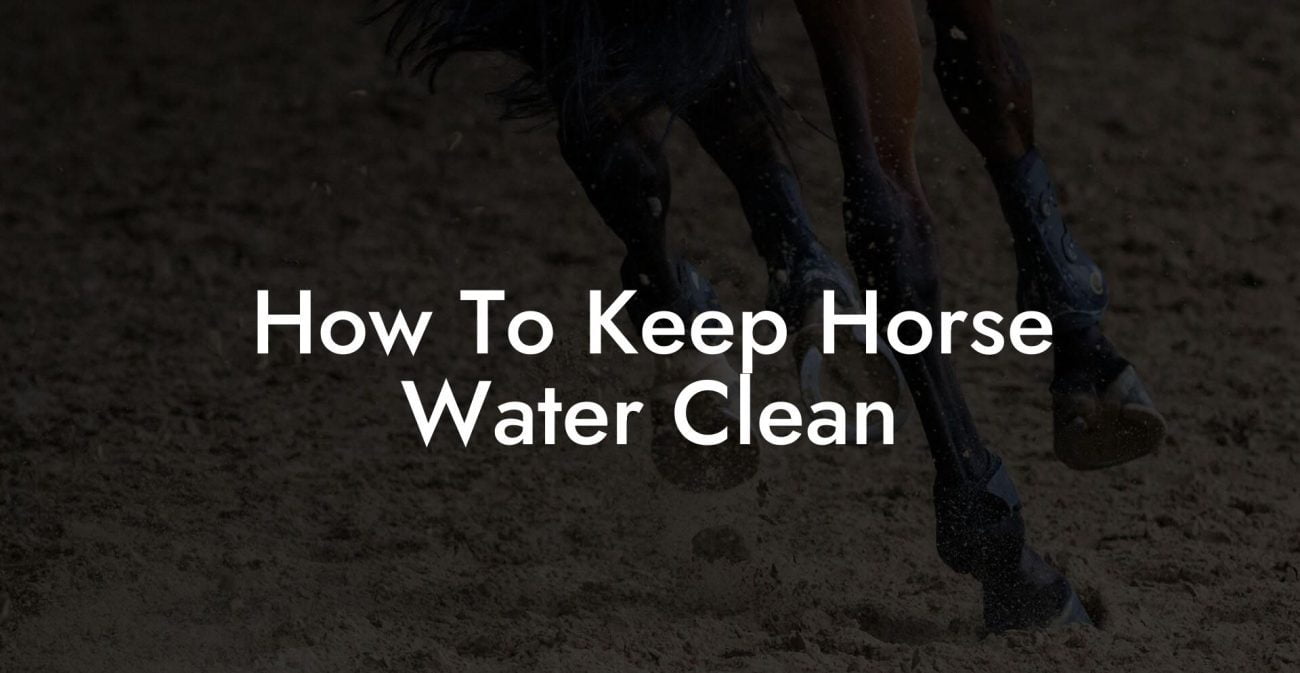Ever found yourself staring at a mountain of horse manure wondering if you should call in a hazmat team or simply channel your inner eco-warrior? Horse manure might seem like a stubborn, smelly nuisance, but when handled the right way, it can become a goldmine of organic compost for your garden, or a catalyst for an eco-friendly revolution! Whether you’re a millennial horse enthusiast or a Gen-Z equine expert, this in-depth guide dives headfirst into the wild world of horse manure management. Buckle up for a no-nonsense, humor-infused journey on how to get rid of horse manure while taking care of your four-legged friend and Mother Nature.
Quick Links to Useful Sections
- Understanding Horse Manure: More Than Just a Stinky Pile
- The Essential Reasons You Need to Get Rid of Horse Manure (and What to Do With It Instead)
- Safety First: Precautions When Handling Horse Manure
- Gear Up!
- Proper Tools
- Hygiene is Everything
- How to Get Rid of Horse Manure: Your Guide to Smarter Disposal
- 1. Direct Removal: The Basics of Manure Collection
- 2. Composting: Turning Waste into Nutrient Gold
- 3. Bagging and Landfilling: When Compost Isn’t an Option
- 4. Spreading as Fertilizer: Direct Application to Landscapes
- 5. Biogas Production: A High-Tech, Eco-Friendly Option
- The Manure Composting Masterclass: Step-by-Step to a Rich, Organic Fertilizer
- Step 1: Location, Location, Location!
- Step 2: Building Your Compost Pile
- Step 3: Aeration and Moisture Control
- Step 4: Patience and Timing
- Step 5: Application and Benefits
- Innovative Tools and Techniques: Making Horse Manure Management a Breeze
- Mechanized Manure Forks and Scoops
- Compost Tumblers
- Mobile Apps and Digital Reminders
- Eco-Friendly Solutions and the Future of Manure Management
- Recycling Nutrients
- Reducing Greenhouse Gases
- Sustainable Energy Production
- Diving into DIY Manure Management: Tips for the Resourceful Horse Owner
- Building a Homemade Compost Bin
- Create a Manure Separation System
- Repurposing Old Equipment
- Dealing with Odors: Keeping Your Stable Fresh and Inviting
- Regular Cleaning and Disposal
- Natural Additives
- Ventilation and Airflow
- Resources and Community Support: Your Next Steps
- Planning Your Manure-Free, Eco-Friendly Stable Routine
- Establish a Daily Manure Check
- Incorporate Manure Management into Your Routine
- Track Your Progress
- Mix in Some Fun
- Common Questions About Horse Manure Management (FAQs)
- Your Journey to a Manure-Free, Eco-Friendly Stable
Understanding Horse Manure: More Than Just a Stinky Pile
Horse manure isn’t just gross, smelly poop, it’s a nutrient-packed, organic resource that, if managed well, can work wonders for your garden and pasture. The bulk of a horse’s diet typically consists of fibrous hay and fresh pasture, resulting in manure that packs plenty of fiber, nitrogen, and trace minerals. But here’s the catch: if left unattended, that same manure can become a breeding ground for pests, pathogens, and unwanted odors.
Before you start lugging heaps of manure off your property, it’s crucial to understand what you’re dealing with. Horse manure is chunky, moist, and has a tendency to clump together, making it excellent for composting, but only with a bit of TLC!
In terms of its impact on your stable environment, the manure also plays a role in ammonia buildup, which can lead to respiratory irritants for both horses and humans. So yes, while it smells like the Earth’s less glamorous side, horse manure is also a powerhouse of nutrients if handled in the right way.
The Essential Reasons You Need to Get Rid of Horse Manure (and What to Do With It Instead)
You might be asking, “Why can’t I just let nature take its course?” Well, here are some compelling reasons:
- Hygiene and health: An overflow of manure can harbor harmful bacteria and parasites that may spread diseases.
- Odor Control: Accumulated manure produces a potent, if not eye-watering, odor that can seep into your living spaces.
- Environmental Impact: Proper disposal prevents runoff into your nearby streams, affecting local wildlife and ecosystems.
- Utilization as a Resource: When composted correctly, horse manure transforms into a rich fertilizer, enhancing soil fertility and reducing waste.
Managing manure isn’t just about hauling it away, it’s about reinventing waste as a valuable resource. Getting rid of horse manure, in a controlled and expert manner, means turning a potential problem into a sustainable solution.
Safety First: Precautions When Handling Horse Manure
Let’s put on our safety goggles and cover the basics of handling horse manure without turning your arms, nose, or overall vibe into a biohazard:
Gear Up!
Whether you’re manually shoveling manure or operating machinery, always wear durable gloves, long sleeves, and possibly a facemask. Horse manure can harbor bacteria like E. coli and Salmonella, and you don’t want to be their next VIP guest.
Proper Tools
Invest in quality manure forks, wheelbarrows, and shovels with ergonomic handles. These tools not only ease the physical labor but also help you manage the manure efficiently without scooping in too much dirt.
Hygiene is Everything
Once your manure mission is complete, wash up thoroughly. Keeping a designated "manure-handling kit" with sanitizing wipes and soap near your work area can save you a lot of post-cleanup hassle.
How to Get Rid of Horse Manure: Your Guide to Smarter Disposal
When it comes to disposing of horse manure, one size definitely does not fit all. The method you choose will depend on your goals, whether you aim for a pristine stable, enhanced garden soil, or even a low-impact environmental footprint.
Here, we’ll break down various approaches for tackling that pile of poop, ranging from strategic removal methods to resourceful repurposing into organic compost.
1. Direct Removal: The Basics of Manure Collection
Often, the first step is simply scooping out the manure on a regular schedule. Frequent removal prevents the buildup of ammonia and minimizes health risks. Retrieve it from paddocks, stalls, and pastures to maintain a clean, healthy environment.
2. Composting: Turning Waste into Nutrient Gold
One of the most popular methods for disposing of horse manure is composting. By creating a properly managed compost pile, you can transform raw manure into nutrient-rich compost that improves soil fertility dramatically. Here’s a breakdown of the process:
- Mixing: Combine manure with carbon-rich materials like straw, sawdust, or dried leaves to balance moisture and speed up the decomposition process.
- Turning: Regularly aerate the pile to keep the microbial action vigorous. This also helps control the odor!
- Moisture: Ensure the mixture is damp (but not soggy) to optimize the composting conditions.
- Time: With proper management, manure compost is generally ready in about 6-12 months.
Pro tip: Add a compost activator or some finished compost to jumpstart the bacterial party.
3. Bagging and Landfilling: When Compost Isn’t an Option
For those times when composting isn’t feasible, maybe due to lack of space or time, bagging the manure and having it picked up by a waste management service is a viable alternative. This method needs proper segregation from regular trash and, in some areas, specialized facilities that can process organic waste.
4. Spreading as Fertilizer: Direct Application to Landscapes
If you’re itching to boost your garden’s fertility, you can directly spread manure on fields or gardens. However, caution is key! Fresh manure can "burn" plants because of its high nitrogen content. It’s often recommended to either compost the manure first or let it age for several months to allow nutrients to balance out.
5. Biogas Production: A High-Tech, Eco-Friendly Option
For those with access to advanced facilities, horse manure can be used in biogas plants to produce renewable energy. In these systems, manure is broken down in controlled, oxygen-free environments (anaerobic digesters), resulting in biogas that can be used for cooking, heating, or electricity generation. Though this method requires initial investment and technical know-how, it’s a fantastic option for those aiming to push the envelope on sustainability.
The Manure Composting Masterclass: Step-by-Step to a Rich, Organic Fertilizer
Composting horse manure is not just about getting rid of waste, it’s about converting it into black gold for your garden. This eco-friendly process minimizes your stable’s odor while providing your crops and pastures with essential nutrients.
Step 1: Location, Location, Location!
Choose a well-drained area that is accessible but not too close to water sources or your living quarters, the last thing you need is an inadvertent compost hotspot in your backyard BBQ area!
Step 2: Building Your Compost Pile
Start by creating a base layer of coarse materials like straw or wood chips. Then alternate layers of manure and carbon-rich material (sawdust, leaves, or shredded paper). Aim for a good balance, roughly a 2:1 ratio of carbon to manure is ideal.
Step 3: Aeration and Moisture Control
Turn the pile every few weeks. This introduces oxygen, helping beneficial microbes do their work, and ensures even decomposition. Keep an eye on the moisture, your compost should be as damp as a wrung-out sponge.
Step 4: Patience and Timing
Composting isn’t an overnight miracle. Allow your manure pile to mature for a minimum of six months, though a year will yield even richer compost. When the pile has turned dark, crumbly, and earthy-smelling, you know it’s ready for use.
Step 5: Application and Benefits
Once your compost has cooled and matured, spread it generously across your garden beds or mix it with potting soil. The resulting fertilizer improves soil structure, boosts microbial activity, and promotes robust plant growth. Not to mention, you’ll be the envy of your fellow horse enthusiasts and eco-warriors!
Innovative Tools and Techniques: Making Horse Manure Management a Breeze
The era of back-breaking labor is over, modern solutions can simplify your manure management tasks. To stay ahead of the game, here are some innovative tools and techniques that blend technology and tradition.
Mechanized Manure Forks and Scoops
If you manage a large stable or acreage, investing in mechanized manure removal equipment can be a game-changer. These specialized forks and scoops are designed to handle manure efficiently, reducing physical strain while increasing productivity.
Compost Tumblers
For those who have less space but still want to compost, consider a compost tumbler. These devices allow you to mix and aerate manure (and other organic waste) more quickly and uniformly than by hand. Simply toss your manure and carbon-rich materials inside, rotate regularly, and watch your compost transform.
Mobile Apps and Digital Reminders
In our hyper-connected world, even manure management has gone digital. There are apps available that help you track the state of your compost pile, remind you when to turn it, and even log the progress of decomposition. Incorporating technology helps reduce guesswork and keeps your routine smooth.
By embracing these innovative and efficient tools, you not only save time and energy but also ensure that your manure management process is as eco-friendly as it is effective.
Eco-Friendly Solutions and the Future of Manure Management
Sustainability isn’t just a buzzword, it’s a way of life, especially when dealing with organic waste. As environmental awareness grows, so does the need for eco-friendly manure management solutions. The goal is not simply to dispose of manure but to transform it into an asset that contributes to the health of your land and the planet.
Recycling Nutrients
By turning horse manure into compost, you recycle essential nutrients like nitrogen, phosphorus, and potassium back into the soil. This not only reduces the need for chemical fertilizers but also supports microbial life, which is crucial for nutrient absorption in plants.
Reducing Greenhouse Gases
When managed properly, composting can significantly reduce methane emissions, a potent greenhouse gas produced by anaerobic decomposition in landfills. By aerating your manure pile and composting, you’re contributing to a reduction in environmental emissions.
Sustainable Energy Production
As mentioned earlier, large-scale biogas production from manure is gaining traction. This renewable energy source not only reduces dependence on fossil fuels but also offers a sustainable way to convert waste into power.
The future of manure management is about creating closed-loop systems where every drop of nutrient is recycled. It’s an exciting time for eco-innovators and horse owners alike, by embracing sustainable practices, you’re investing in a healthier environment for generations to come.
Diving into DIY Manure Management: Tips for the Resourceful Horse Owner
For those who love a good DIY project or are operating on a tighter budget, fear not, there are plenty of ways to manage horse manure without breaking the bank. Here are some down-to-earth, practical ideas to transform your manure management routine:
Building a Homemade Compost Bin
You don’t need a fancy store-bought unit to start composting. With just a few pallets, some hinges, and a bit of creativity, you can build your very own compost bin tailor-made for your stable’s workload. Customize it to fit your space and style (bonus points for quirky decorations!).
Create a Manure Separation System
Particularly in larger stables, separating urine from manure can improve the composting process by reducing moisture levels and odor. Simple screen systems or slatted floors allow liquid to drain away while keeping the solid manure in place.
Repurposing Old Equipment
Got an old wheelbarrow or discarded shelving unit? Repurpose these items into storage or composting stands for your manure. With a bit of elbow grease and creativity, you can set up an efficient manure management station that reflects your unique style.
This DIY mentality not only saves money but also reinforces the sustainable, resourceful approach that defines modern horse care. Charm and ingenuity go a long way in turning a stinky chore into a fun, rewarding project.
Dealing with Odors: Keeping Your Stable Fresh and Inviting
Let’s face it, no one wants their stable to double as an industrial waste site. Odor control is paramount when it comes to managing horse manure. With the right techniques, you can keep those whiffs in check and even transform your manure management process into one that’s nearly odor-neutral.
Regular Cleaning and Disposal
Frequency is key. The more regularly you remove manure from stalls and paddocks, the less time it has to break down and generate unpleasant odors. A proactive cleaning schedule makes the whole process much easier and more effective.
Natural Additives
Consider mixing natural odor absorbers like zeolite, biochar, or even essential oils (think eucalyptus or tea tree) into your compost pile. These additives help neutralize the smell while also lending additional benefits to your compost.
Ventilation and Airflow
If you’re composting in a contained space, ensuring proper ventilation is crucial. Good airflow prevents the buildup of anaerobic conditions, which are often the culprits behind that pungent aroma.
With these odor-control strategies, you can maintain a stable that is as pleasant to work in as it is efficient at managing manure.
Resources and Community Support: Your Next Steps
You’re not alone on this manure management mission. Communities of modern, eco-minded horse owners are out there, ready to share tips, tools, and support. Whether you’re looking for innovative products, DIY tutorials, or advice from seasoned stable managers, tapping into communities can supercharge your approach to horse manure management.
Here are some valuable resources and communities to consider:
- Online Forums: Platforms like The Horse Forum and Chronicle of the Horse feature threads on manure management and sustainable horse care.
- Social Media Groups: Facebook and Reddit have vibrant communities (think r/Horse and r/Permaculture) where you can exchange ideas and experiences with fellow horse lovers.
- Local Cooperative Extensions: Many areas have agricultural extension offices that offer guidance on composting and organic waste management.
- Workshops and Webinars: Look out for online or in-person events hosted by environmental organizations that focus on sustainable agriculture and waste management.
- Manufacturer and Supplier Websites: If you’re interested in cutting-edge tools, check out the sites of companies that specialize in manure management equipment and eco-friendly supplements.
Engaging with a supportive community not only keeps you updated on the latest strategies but also makes the journey a lot more enjoyable. Sharing your successes (and even your manure mishaps) builds a network of like-minded individuals passionate about optimizing both horse care and ecological sustainability.
Planning Your Manure-Free, Eco-Friendly Stable Routine
It’s time to take charge and transform your stable management workflow into something that’s efficient, sustainable, and even a little fun! When it comes to getting rid of horse manure, a consistent routine can make all the difference. Here are some actionable steps:
Establish a Daily Manure Check
Start each day with a quick inspection of your paddocks and stalls. The sooner you identify accumulations, the faster you can tackle them before they escalate into full-blown odor factories.
Incorporate Manure Management into Your Routine
Make manure removal a regular part of your daily or weekly stable chores. Whether it’s setting aside 30 minutes every morning or scheduling shifts with fellow stable hands, consistency is essential.
Track Your Progress
Keep a log or use an app to track when and how much manure you remove, the state of your compost piles, and the success of any odor control measures. Data-driven adjustments can help you fine-tune your approach over time.
Mix in Some Fun
Yes, manure management is serious business, but that doesn’t mean it can’t be fun! Put on your favorite tunes, challenge yourself to beat the previous day’s “manure management record,” or share a meme with your stable mates. A little humor goes a long way in keeping the hard work enjoyable.
By integrating these steps into your daily routine, you ensure that getting rid of horse manure isn’t a daunting chore, but a manageable, and even rewarding, process that contributes to both your stable’s cleanliness and your environmental impact.
Common Questions About Horse Manure Management (FAQs)
We’ve gathered some of the most frequently asked questions by horse owners, eco-warriors, and curious minds alike. Whether you're new to manure management or looking to refine your process, these FAQs have you covered.
1. Why is it important to manage horse manure regularly?
Regular management prevents the buildup of harmful bacteria, reduces odors, improves the health of your stable environment, and transforms manure into a valuable resource like compost.
2. Can I simply leave the manure in my paddock?
While small amounts may decompose naturally, leaving manure unattended for extended periods can lead to health hazards, unpleasant odors, and nutrient runoff that can harm the environment.
3. What is the best method for composting horse manure?
The most effective method combines manure with carbon-rich materials such as straw or sawdust, ensures proper aeration and moisture levels, and allows a maturation period of 6-12 months for optimal decomposition.
4. Is there any risk associated with handling horse manure?
Yes, horse manure can harbor bacteria and parasites. Always wear gloves, use proper tools, and maintain clean hygiene practices when handling manure.
5. How can I control the smell in my compost pile?
Regular turning, maintaining the right moisture balance, using natural additives like biochar or essential oils, and ensuring proper ventilation are all effective measures to control odors.
6. Can manure be used directly as fertilizer?
Fresh manure can be too strong for plants. It’s best to compost or let it age before applying directly as fertilizer to avoid plant burn and nutrient imbalances.
7. What kind of equipment can make manure removal easier?
From mechanized manure forks and scoops to compost tumblers and digital reminder apps, modern equipment can significantly streamline the removal and composting process.
8. How does composted manure benefit soil health?
Composted manure enriches soil with organic matter and essential nutrients, boosts microbial activity, improves water retention, and contributes to overall plant health.
9. Can manure management techniques vary depending on your stable’s size?
Absolutely. Methods and equipment should be tailored to your specific needs, whether you’re managing a small backyard stable or a large commercial facility.
10. Are there any eco-friendly technologies that can utilize horse manure for energy?
Yes, anaerobic digestion in biogas plants can convert manure into renewable energy, providing an environmentally friendly alternative to fossil fuels.
Your Journey to a Manure-Free, Eco-Friendly Stable
Transforming horse manure management is more than just cleaning up a mess, it’s a journey toward a sustainable lifestyle that benefits your stables, your garden, and the environment. Through the proper disposal, composting, and recycling of manure, you turn an everyday challenge into a celebration of resourcefulness and eco-consciousness.
With the blend of practical tips, innovative tools, and hands-on DIY projects discussed here, you’re equipped to handle that notorious pile of manure like a pro. Whether you aim to keep your stable fresh and hygienic, boost your garden’s fertility, or contribute to renewable energy, every step you take adds up to a greener, cleaner future.
Embrace your inner eco-warrior and let this guide be the spark that motivates you to transform manure management from an overwhelming chore into an empowering daily practice. With a bit of humor, a lot of creativity, and a passion for sustainability, your stable can be both a functional haven for your horse and a model of environmentally friendly care.
So, roll up your sleeves, put on your favorite playlist, and embark on your journey toward a manure-free, eco-friendly future, where every heap of horse manure is an opportunity waiting to become rich, dark compost, a true testament to innovative, responsible horse care.













